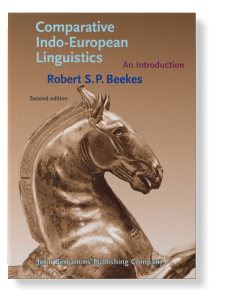Comparative Indo-European Linguistics
An introduction
Second edition
The reader is introduced into the nature of language change and the methods of reconstruction of older language stages, with many examples (from the Indo-European languages). A full description is given of the sound changes, which makes it possible to follow the origin of the different Indo-European languages step by step. This is followed by a discussion of the development of all the morphological categories of Proto-Indo-European.
The book presents the latest in scholarly insights, like the laryngeal and glottalic theory, the accentuation, the ablaut patterns, and these are systematically integrated into the treatment.
The text of this second edition has been corrected and updated by Michiel de Vaan. Sixty-six new exercises enable the student to practice the reconstruction of PIE phonology and morphology.
Comparative Indo-European Linguistics: An introduction, Robert S.P. Beekes (1995)
Table of Contents
-
Preface | pp. xv–xvii
-
Preface to the Second Edition | pp. xix–xx
-
List of Abbreviations | pp. xxi–xxii
-
Transcription | p. xxiii
-
List of Exercises | p. xxiv
-
Part I
-
General section
-
1. Introduction | pp. 3–9
-
2. The Indo-European Family of Languages | pp. 11–33
-
3. The Culture and Origin of the Indo-Europeans | pp. 35–53
-
4. Sound Change | pp. 55–71
-
Language change
-
5. Analogy | pp. 75–82
-
6. Other Form-Changes | pp. 83–84
-
7. Vocabulary Changes | pp. 85–92
-
8. Morphological and Syntactic Change | pp. 93–98
-
Reconstruction
-
9. Internal Reconstruction | pp. 99–103
-
10. The Comparative Method | pp. 107–115
-
Part II
-
Comparative Indo-European Linguistics
-
11. The Sounds and the Accent | pp. 119–167
-
Morphology
-
12. Introduction | pp. 171–178
-
13. The Substantive | pp. 179–217
-
14. The Adjective | pp. 219–223
-
15. The Pronoun | pp. 225–236
-
16. The Numerals | pp. 237–243
-
17. Indeclinable Words | pp. 245–250
-
18. The Verb | pp. 251–288
-
Appendix | pp. 289–310
-
-
Maps | pp. 343–358
-
Illustrations | pp. 359–386
-
Indexes | pp. 387–415
Cited by
Cited by 52 other publications
This list is based on CrossRef data as of 20 april 2024. Please note that it may not be complete. Sources presented here have been supplied by the respective publishers. Any errors therein should be reported to them.

